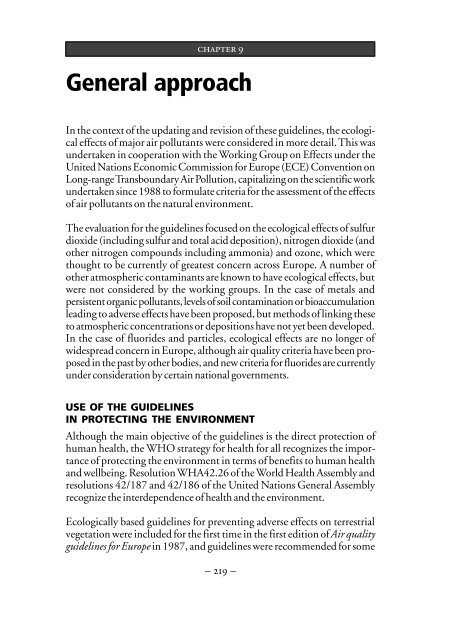Air Quality Guidelines - World Health Organization Regional Office ...
Air Quality Guidelines - World Health Organization Regional Office ...
Air Quality Guidelines - World Health Organization Regional Office ...
Create successful ePaper yourself
Turn your PDF publications into a flip-book with our unique Google optimized e-Paper software.
introduction chapter 9<br />
General approach<br />
In the context of the updating and revision of these guidelines, the ecological<br />
effects of major air pollutants were considered in more detail. This was<br />
undertaken in cooperation with the Working Group on Effects under the<br />
United Nations Economic Commission for Europe (ECE) Convention on<br />
Long-range Transboundary <strong>Air</strong> Pollution, capitalizing on the scientific work<br />
undertaken since 1988 to formulate criteria for the assessment of the effects<br />
of air pollutants on the natural environment.<br />
The evaluation for the guidelines focused on the ecological effects of sulfur<br />
dioxide (including sulfur and total acid deposition), nitrogen dioxide (and<br />
other nitrogen compounds including ammonia) and ozone, which were<br />
thought to be currently of greatest concern across Europe. A number of<br />
other atmospheric contaminants are known to have ecological effects, but<br />
were not considered by the working groups. In the case of metals and<br />
persistent organic pollutants, levels of soil contamination or bioaccumulation<br />
leading to adverse effects have been proposed, but methods of linking these<br />
to atmospheric concentrations or depositions have not yet been developed.<br />
In the case of fluorides and particles, ecological effects are no longer of<br />
widespread concern in Europe, although air quality criteria have been proposed<br />
in the past by other bodies, and new criteria for fluorides are currently<br />
under consideration by certain national governments.<br />
USE OF THE GUIDELINES<br />
IN PROTECTING THE ENVIRONMENT<br />
Although the main objective of the guidelines is the direct protection of<br />
human health, the WHO strategy for health for all recognizes the importance<br />
of protecting the environment in terms of benefits to human health<br />
and wellbeing. Resolution WHA42.26 of the <strong>World</strong> <strong>Health</strong> Assembly and<br />
resolutions 42/187 and 42/186 of the United Nations General Assembly<br />
recognize the interdependence of health and the environment.<br />
Ecologically based guidelines for preventing adverse effects on terrestrial<br />
vegetation were included for the first time in the first edition of <strong>Air</strong> quality<br />
guidelines for Europe in 1987, and guidelines were recommended for some<br />
– 219 –

















